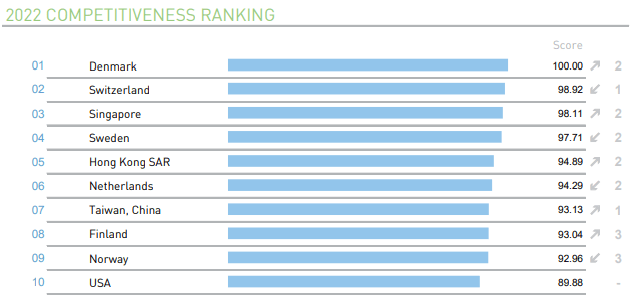Denmark, Switzerland, Singapore, Sweden, Hong Kong, the Netherlands, Taiwan, Finland and Norway were the most competitive countries in the world in 2022, according to the IMD World Competitiveness Ranking 2022.
Denmark reached the top spot for the first time in the ranking’s 34-year history, taking third place in 2021.

In particular, Denmark performed outstandingly on the business efficiency factor (first) and on the productivity and efficiency (first) and management practices (first) sub-factors. Switzerland dropped to second place (from first) and Singapore recovered to third (from fifth).
“Denmark is the most digitally advanced country in the world and is now in the top spot thanks to good policies, the benefits of being a European country, a clear focus on sustainability and the drive of its nimble business sector,” said Professor Arturo Bris, director of the CMI.
Most competitive countries
The 34th edition of the IMD World Competitiveness Yearbook is released at a time of tremendous upheaval.
Covid-19 continues to affect much of the world. Interestingly, while comprehensive efforts are underway in some countries to return to a state of normality, other parts of the world are experiencing a massive increase in the number of infected people.
In addition to the health and economic risks that countries are struggling to address, the IMD highlighted that an additional dangerous situation has emerged: geopolitical risk that has been reintroduced by the Russian invasion of Ukraine.
The IMD World Competitiveness Yearbook (WCY), first published in 1989, is a comprehensive annual report and global benchmark on the competitiveness of countries.
It provides comparative analysis and trends, as well as statistics and survey data based on extensive research.
It also analyzes and classifies countries according to how they manage their skills to achieve long-term value creation.
The competitiveness of an economy cannot be reduced solely to GDP and productivity because companies also have to deal with political, social and cultural dimensions.
Therefore, governments must provide an environment characterized by efficient infrastructure, institutions and policies that encourage sustainable value creation by companies.
The IMD World Competitiveness Rankings emphasize a long-term trend highlighted in previous editions: that the countries at the top of the list each have a unique approach to becoming competitive.
![]()

